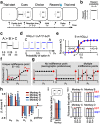Nonhuman Primates Satisfy Utility Maximization in Compliance with the Continuity Axiom of Expected Utility Theory
- PMID: 33542082
- PMCID: PMC8018892
- DOI: 10.1523/JNEUROSCI.0955-20.2020
Nonhuman Primates Satisfy Utility Maximization in Compliance with the Continuity Axiom of Expected Utility Theory
Abstract
Expected Utility Theory (EUT), the first axiomatic theory of risky choice, describes choices as a utility maximization process: decision makers assign a subjective value (utility) to each choice option and choose the one with the highest utility. The continuity axiom, central to Expected Utility Theory and its modifications, is a necessary and sufficient condition for the definition of numerical utilities. The axiom requires decision makers to be indifferent between a gamble and a specific probabilistic combination of a more preferred and a less preferred gamble. While previous studies demonstrated that monkeys choose according to combinations of objective reward magnitude and probability, a concept-driven experimental approach for assessing the axiomatically defined conditions for maximizing utility by animals is missing. We experimentally tested the continuity axiom for a broad class of gamble types in 4 male rhesus macaque monkeys, showing that their choice behavior complied with the existence of a numerical utility measure as defined by the economic theory. We used the numerical quantity specified in the continuity axiom to characterize subjective preferences in a magnitude-probability space. This mapping highlighted a trade-off relation between reward magnitudes and probabilities, compatible with the existence of a utility function underlying subjective value computation. These results support the existence of a numerical utility function able to describe choices, allowing for the investigation of the neuronal substrates responsible for coding such rigorously defined quantity.SIGNIFICANCE STATEMENT A common assumption of several economic choice theories is that decisions result from the comparison of subjectively assigned values (utilities). This study demonstrated the compliance of monkey behavior with the continuity axiom of Expected Utility Theory, implying a subjective magnitude-probability trade-off relation, which supports the existence of numerical utility directly linked to the theoretical economic framework. We determined a numerical utility measure able to describe choices, which can serve as a correlate for the neuronal activity in the quest for brain structures and mechanisms guiding decisions.
Keywords: continuity axiom; decision making; expected utility theory; reward risk; utility.
Copyright © 2021 Ferrari-Toniolo et al.
Figures









References
-
- Allais M (1953) Le Comportement de l'Homme Rationnel devant le Risque: critique des Postulats et Axiomes de l'Ecole Americaine. Econometrica 21:503. 10.2307/1907921 - DOI
-
- Battalio RC, Kagel JH, MacDonald DN (1985) Animals' choices over uncertain outcomes: some initial experimental results. Am Econ Rev 75:597–613.
-
- Benjamini Y, Hochberg Y (1995) Controlling the false discovery rate: a practical and powerful approach to multiple testing. J R Stat Soc Ser B 57:289–300.
-
- Camerer CF (1989) An experimental test of several generalized utility theories. J Risk Uncertainty 2:61–104. 10.1007/BF00055711 - DOI
Publication types
MeSH terms
Grants and funding
LinkOut - more resources
Full Text Sources
Other Literature Sources
